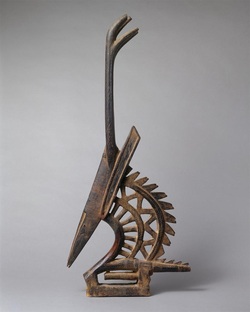The Ndomo and Ci Wara.

The Bamana from Mali have training for young boys in their culture. This training is called the Ndomo and they wear masks that teach the boys principles of conduct and they also receive training on the opposite sex. The boys are between the ages of 8-11 when they receive this training. At this age they are taken away from their families and live in a contemporary shelter where they are then taught these principles and qualities.[1] The Ndomo prepares them for Ci Wara which will partner them up with young girls and teach them agriculture skills. Along with this they will be taught how to provide for their families and how to be a good community member. The Ndomo masks and Ci Wara masks are carved out of wood and could be covered in cowrie shells, blood-red seeds or shining brass.[2] Leadership can be seen through the teaching of others. Obviously, young boys and girls are taught the principles of living in their culture here.
[1] Monica Blackmun Visonà, Robin Poynor, and Herbert M. Cole, A History of Art in Africa, (Upper Saddle River, N.J.: Pearson Education, Inc., 2008), 116.
[2] Visonà, page 115.
[1] Monica Blackmun Visonà, Robin Poynor, and Herbert M. Cole, A History of Art in Africa, (Upper Saddle River, N.J.: Pearson Education, Inc., 2008), 116.
[2] Visonà, page 115.
Headdress: Male Antelope (Ci Wara), 19th-early 20th century, Wood, metal bands, thread, H x W x D: 35 11/16 x 15 3/4 x 3 3/8in. (90.7 x 40 x 8.5cm), (Image © The Metropolitan Museum of Art)
